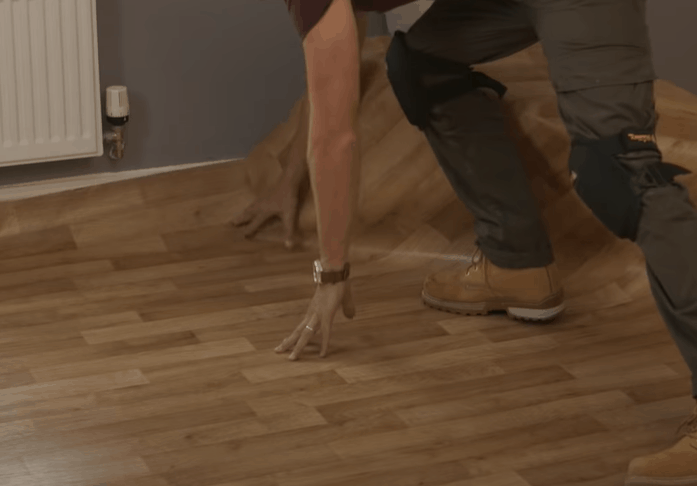

Leave the glue to set for the time indicated in the instructions and install your vinyl planks following the method described above. Use a spreader tool designed for this purpose to apply the correct amount of adhesive (usually about 300 g per m²). However, a glue down floor needs to be held in place using a permanent vinyl floor adhesive. Just like with loose lay vinyl floors, you will have to apply adhesive. Your vinyl planks will be held securely in place but it will be possible to remove them if you need to change them. This can take anywhere from 30 minutes to two hours, depending on the product. Leave the tackifier to cure according to the instructions before installing your vinyl planks. In this case, you will need to apply a tackifier using a notched adhesive spreader. Loose lay vinyl plank flooringĪlternatively, you might want to install a loose lay vinyl floor. Use this off-cut to start the second row and repeat for the next row.
#Laying a vinyl floor full
Once again, start by fitting a full plank and cut the last plank in a row to size. The basic installation method is the same except that the floor is held in place by adhesive. If you decide against a click vinyl floor, the other option is to install a glue down floor. The type of locking system used can vary depending on the product. Be sure to lock the planks together properly to prevent them from disconnecting later on. Repeat the process until your entire surface is covered. Set about installing the second row using the off-cut from the first row (as long as it measures over 25 cm) before slotting in a full plank. It is recommended to use a pull bar to slot the last plank in a row into place. Please note that your cuts should be made on the decorative side of the board and not on the underside. Use a straight edge to run your utility knife firmly along the board to score it. Use a utility knife to cut the last plank in the row to size. Slot the second plank along the shortest side of the first and continue laying full planks along the wall until you run out of room. To leave the required gap (usually around 8 mm), you can use wooden spacers. It's important to leave an expansion gap around the perimeter of the room. It is usually recommended to fit an underlay first.Īfter rolling out the underlay, fit your first full plank in one corner of the room. This means you can easily dismantle the floor without damaging the surface itself.įitting a floating vinyl plank floor is very similar to installing laminate. Most vinyl plank floors are fitted as floating installations. Prepare the surface: an essential step for any installation.For a click floor of the same size, set aside around half a day for installation.You will need a full day to fit a glue down vinyl floor stretching 20-30 m².But you will have to be able to take accurate measurements and be comfortable using a utility knife. Required skillsĪny DIYer should be able to fit a vinyl plank floor.
:max_bytes(150000):strip_icc()/easy-install-plank-vinyl-flooring-1822808-09-a1f83db7bdf74f279f45594b897de82d.jpg)
Whether you go for a glue down floor (such as a loose lay or self-adhesive vinyl floor) or a click floor, the same basic installation rules apply but the techniques do differ. There's also a lot of choice when it comes to installation with a multitude of different formats and methods to choose from. Used to revamp old lino or any other type of floor, vinyl planks come in a wide variety of styles so you're sure to find the perfect solution for any room of the home. These days, you are sure to find a range of vinyl flooring on the shelves of any DIY or flooring shop. Vinyl plank floors are officially on the rise.


 0 kommentar(er)
0 kommentar(er)
